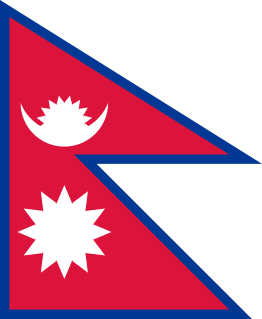 W
WThe emblem of Nepal was changed during the reconciliation period following the Nepalese Civil War. On 28 May 2008, a new emblem in the style of socialist heraldry was introduced. On 13 June 2020, the emblem was revised to include the newly issued map which includes the Kalapani territory and Lipulekh pass.
 W
WDaura-Suruwal is one of the national outfit of Nepalese men. The Daura is a variant of the Kurta and is the upper garment, the Suruwal is the trouser. The coat was added to the costume by Jang Bahadur Rana, a prime minister of Nepal in the 19th century. The outfit is also popular in Darjeeling in neighbouring India amongst people of Nepali origin.
 W
WThe national flag of Nepal is the world's only non-quadrilateral flag that acts as both the state flag and civil flag of a sovereign country. The flag is a simplified combination of two single pennons, known as a double-pennon. Its crimson red is the symbol of bravery and it also represents the color of the rhododendron, Nepal's national flower, while the blue border is the color of peace. Until 1962, the flag's emblems, both the sun and the crescent moon, had human faces, but they were removed to modernize the flag.
 W
W"Janani Janmabhumishcha Swargadapi Gariyasi" is a hemistich of a Sanskrit shloka, and the national motto of Nepal.
 W
WThe Himalayan monal, also known as the Impeyan monal and Impeyan pheasant, is a pheasant native to Himalayan forests and shrublands at elevations of 2,100–4,500 m (6,900–14,800 ft). It is part of the family Phasianidae and is listed as Least Concern on the IUCN Red List. It is the national bird of Nepal, where it is known as the danphe or danfe, and state bird of Uttarakhand, India, where it is known as the monal. It was also the state bird of Himachal Pradesh until 2007.
 W
WNepali is an Indo-Aryan language of the sub-branch of Eastern Pahari. It is the official language of Nepal and one of the 22 scheduled languages of India. Also known by the endonym Khas kura, the language is also called Nepalese, Gorkhali or Parbatiya in some contexts. It is spoken mainly in Nepal and by about a quarter of the population in Bhutan. In India, Nepali has official status in the state of Sikkim and in the Darjeeling District and Kalimpong district of West Bengal. It has a significant number of speakers in the states of Arunachal Pradesh, Assam, Himachal Pradesh, Manipur, Mizoram and Uttarakhand. It is also spoken in Myanmar and by the Nepali diaspora worldwide. Nepali developed in proximity to a number of Indo-Aryan languages, most notably the other Pahari languages and Maithili and shows Sanskrit influence. However, owing to Nepal's location, it has also been influenced by Tibeto-Burman languages. Nepali is mainly differentiated from Central Pahari, both in grammar and vocabulary, by Tibeto-Burman idioms owing to close contact with this language group.
 W
WRhododendron is a very large genus of 1,024 species of woody plants in the heath family (Ericaceae), either evergreen or deciduous, and found mainly in Asia, although it is also widespread throughout lowland and montane forests in the Pacific Northwest, California, the Northeastern United States, and especially in the highlands of the Appalachian Mountains of North America. It is the national flower of Nepal, the state flower of Washington and West Virginia in the United States, the provincial flower of Jiangxi in China and the state tree of Sikkim and Uttarakhand in India. Most species have brightly colored flowers which bloom from late winter through to early summer.
 W
WRhododendron arboreum, the tree rhododendron, is an evergreen shrub or small tree with a showy display of bright red flowers. It is found in Bhutan, China, India, Myanmar, Nepal, Sri Lanka, Pakistan and Thailand. It is the national flower of Nepal. In India it is the state tree of Uttarakhand and state flower of Nagaland.
 W
WNepal Sambat is the lunisolar calendar used by the people of Nepal. The Calendar era began on 20 October 879 AD, with 1142 in Nepal Sambat corresponding to the year 2021–2022 AD. Nepal Sambat appeared on coins, stone and copper plate inscriptions, royal decrees, chronicles, Hindu and Buddhist manuscripts, legal documents and correspondence. Though Nepal Sambat is declared a national calendar and is used widely in Nepal, it is mostly used by the Newar community whereas Bikram Sambat (B.S) remains the dominant calendar throughout the country.
 W
W"Sayaun Thunga Phulka" is the national anthem of Nepal. It was officially adopted as the anthem on 3 August 2007 amidst a ceremony held at the conference hall of National Planning Commission, inside Singha Durbar, by the speaker of the interim parliament, Subash Chandra Nembang. The previous Nepalese national anthem, "Shreeman Gambhir", had been adopted in 1962, but was dropped following the abolishment of the monarchy.